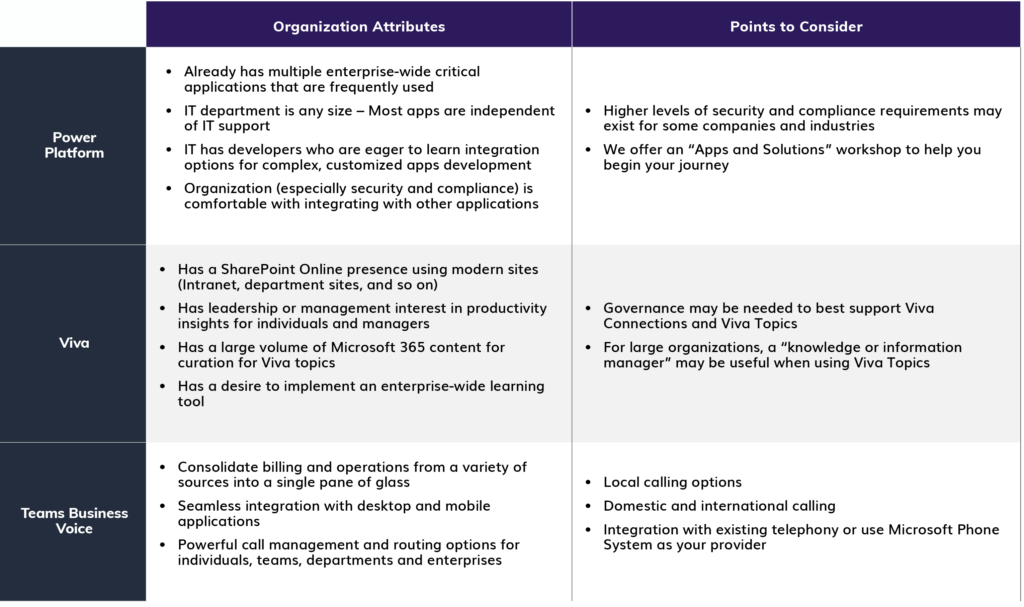We conclude our Teams as a Platform blog series by looking at how you can bring everything together to use Microsoft Teams as a complete solution.
This is Part 4 of a four-part series
Over the previous three blogs, we’ve walked through how to make Microsoft Teams a truly comprehensive, all-in-one digital work hub, how to build a knowledge management (KM) solution, and steps to extend Teams to automate processes and increase engagement in your organization.
This series is meant to be a useful guide, demonstrating how organizations can take Microsoft Teams beyond chats, meetings, calls and group collaboration.
Instead of wondering what you can do with Teams, consider thinking in terms of “what can’t I do with Teams?” In reality, the possibilities are endless, and no two companies will use the platform in the exact same way.
Before dive into the next steps of your journey with Microsoft Teams, there is one final element to consider when setting up the tool as a digital hub – Microsoft Business Voice.
Replacing Traditional Phones with Microsoft Business Voice
As a recent Forrester report noted, companies have transformed their operations and improved how their employees collaborate using solutions like Microsoft Teams over the past several years. To a large extent, telephone-based collaboration was either excluded or left behind.
With Microsoft’s Business Voice integrated into Microsoft Teams, organizations can add voice calling into their collaborative business practices. The report stated that this solution could increase productivity and teamwork, reduce costs, and advance business outcomes. Using both toll and toll-free numbers, you can set up call menus to help callers get to the right department and audio conferencing so you can host meetings and more.
Because Business Voice is a part of Teams, you can turn any computer or mobile device into a phone.
Now, let’s look at how to take all of the elements we’ve covered in this series and move forward with putting them into place.
Determining Causes of Change Resistance Starts at the Executive Level
A word of advice as you implement these solutions: if your company has had some initial challenges in increasing Teams adoption and getting employees to transition away from traditional communication means, work to ensure the organization is not part of the problem.
Take a closer look at issues that relate to the people side of what can be a massive change, from training and communications, change networks or coaching. Be honest in your assessment. For example, did your company provide adequate, in-depth training on the application? Is training and communications ongoing, or were these important steps conducted at a single point in time at the initial deployment?
Not planning for ongoing training and actively working to increase adoption will decrease enthusiasm for the solution, especially if your company continues to use duplicate applications or if there hasn’t been a real push from leadership to encourage people and parts of the organization to fully transition to Teams as its primary communications and collaboration tool.
Companies of all sizes can do even more when they fully invest in Teams and an adoption and change management strategy that increases adoption. If you follow the various recommendations and advice provided in these articles, we can help get you to the next level of Teams’ maturity and adoption, continue to increase your ROI of Microsoft 365 and give your company a competitive advantage over your peers.
Next Steps in your Microsoft Teams as a Platform Journey
Here are the next steps to take on your journey to establishing Microsoft Teams as the primary digital work hub in your company:
- Assess and identify:
- Your business goals and objectives for which collaboration, communication and KM systems you want to improve upon.
- Your current use and maturity of Teams.
- Duplicate collaboration and communication technologies, systems and applications which Teams (and Office 365) may be able to replace.
- Enterprise-wide critical systems your company frequently uses that may have collaboration and communication gaps across large numbers of employees.
- Business processes that require interactions with multiple information systems in a disjointed manner
- Your future “Teams as a Platform” success criteria.
- Microsoft funds that may be available through a Microsoft Partner (like Centric) to better understand how you can leverage Teams as a Platform or to execute your final Teams as a Platform design and implementation.
- Prioritize business goals and objectives.
- Understand and define governance, security and compliance requirements.
- Align technologies, applications and systems against business goals and objectives.
- Analyze how you might use Teams to fill the gaps, improve processes and improve “the flow of work” for the end users of these processes through:
- Out-of-the-box design and feature improvements in Teams supporting end users and processes
- Potential third-party applications
- Customized solutions (apps, bots, connectors, automation flows, dashboards, and more).
- Develop a high-level roadmap to implement your “Teams as a Platform” initiative.
- Gain executive sponsorship and funding for the initiative.
- Develop a high-level Adoption and Change Management plan for the initiative.
- Execute the Roadmap, Adoption and Change Management plan, and the Governance, Security and Compliance plans.
Roadmap: Create Your Customized Journey
Conclusion
We’ve walked through a number of ways you can improve your experience with Microsoft Teams and take the platform to the next level. From using it as a knowledge management solution to a citizen development tool, the functionalities are virtually limitless. Whatever your needs, we hope we’ve shown you with Microsoft Teams the solution is there.


